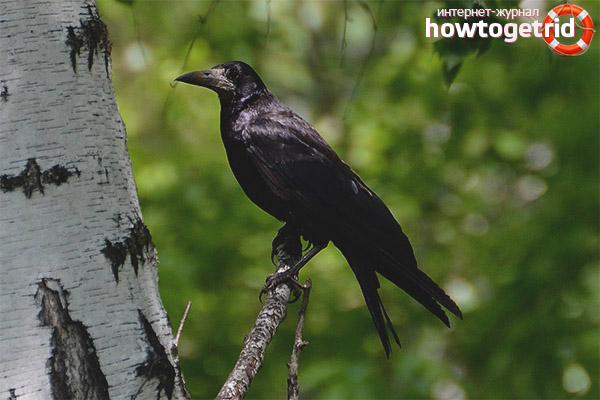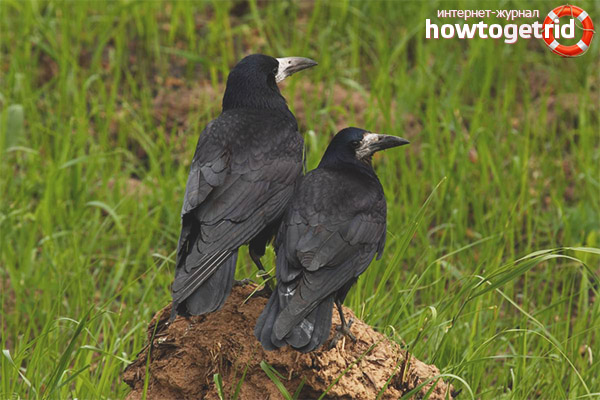The content of the article
Rook belongs to the birds of the raven family. By their external data, these individuals are similar to crows, partly for this reason, even experienced bird lovers confuse the individuals. However, the rooks have some features that distinguish them from ravens. So, these individuals have an elongated and slender body, they have an unspoiled bare skin area (but this trait is absent in young animals). Today we will study other aspects that characterize the rooks.
Description
- Rooks are ranked as a passerine order of birds. These individuals belong to the family of corvids. Partly because of the second feature, many confuse rooks with crows. Many people do not know what is the difference between these individuals. Although by external signs they still manage to be identified.
- Rooks are slender and fit. According to their dimensional features, these birds grow up to 45 cm. The mass of the body varies between 0.45-0.48 kg. A characteristic and distinctive feature is the fact that in the area of the beak the skin is not feathered. However, this feature is peculiar exclusively to older birds.
- If the young growth has not yet reached puberty, it will differ from the adult generation in the shade of plumage. Rooks can not boast of a variety of plumage, these birds are black. The features of this species are characterized by a bluish reflection of feathers with a metallic tint. This feature can be seen in sunlight.
- The beak, as well as the rest of the body, is pigmented in black. He is very strong, strong, with a special structure. Rooks do not sing songs, moreover, they do it terribly. Rather, they talk with a kind of wheezing and rudeness in their voice.
- Also, birds can be like a raven with their croaking. Individuals of this species do not like to imitate humans or other animals. In the process of communication, they use only 2 phrases: kra and kar.
Lifestyle
- These birds are common in European countries. But their habitat is constantly expanding, so today individuals can be found even in unforeseen climatic regions. They are common in Eurasia, stretching from the Pacific Ocean to Scandinavia.
- Birds prefer to settle in the steppe, forest and forest-steppe zones. Until recently, individuals tried to stay away from people, but later they gathered courage and began to develop land next to humans. They are met in large cities and towns.
- This is partly due not only to the curiosity of birds, but also to the fact that humanity is destroying nature and is approaching closer to the habitat of birds. Thus, a destructive process is carried out on the nature of the habitat of these individuals.
- Rooks are understood to mean colonial birds. They are distributed unevenly over the selected territory, occupying certain zones. Also, individuals of this group are characterized by a migratory lifestyle.
- Rooks living in the northern part are migratory. But those individuals living in the southern territory do not leave their native expanses. They lead a sedentary lifestyle.
- Since olden times people with a certain trepidation belonged to rooks. They loved the birds because they foreshadowed the warm weather as soon as they arrived from the winter. In spring, these birds are so eager to return home that they arrive almost the very first.
- In the autumn season, individuals prepare for flight, usually in October or November. At first, the birds look excitedly, prepare, then stray in packs and hit the road. During this period, one can notice how numerous individuals soar in the sky and scream, signaling that it is time to fly away.
- By the end or middle of autumn, these birds are already flying to the place where they plan to winter.They manage to get to the hibernation, because they try to do it before the frost. With the listed species of birds, there are many signs. So, for example, if the rooks left their native expanses, it means that cold will come soon.
- Birds are famous for their unusual behavior. They are friendly in relation to self-similar, they like to communicate and learn something new. Some compare rooks with a small child, curious and kind. Individuals prefer to stay awake during the day, and at night they rest.
- Rookies are considered a favorite game of rooks. Individuals run or fly after each other, talking nicely. Submit items in turn, whether it's a wand or a piece of plastic. When it is warm outside, the birds swing on the branches, as on a swing.
Breeding
- As soon as the first days of early spring come, individuals begin to take care of the construction of dwellings. It is worth noting that rooks relate to this procedure with all responsibility. Also, individuals do not spend a long time in the colonies. Most of the time birds spend on building nests and caring for offspring.
- It is worth noting that the rooks do not show high requirements for the location of the home. Therefore, they can build a nest on any large tree that they like. Among other things, rooks do not seek to hide their nests from strangers. Also, this does not affect the number of individuals considered.
- To build a nest, individuals use their powerful beak. With it, they break dry branches without any problems. It is such a building material that is the basis of a strong nest. Often birds place their dwellings at an altitude of about 16 m. In this case, on one tree there can be up to 20 nests.
- Such birds really value their own work. Therefore, it is often possible to see that individuals occasionally repair their own nests. Such dwellings often remain after last year's nesting. As soon as the birds are distributed among the nests, they begin to form pairs.
- The mating season and mating in birds falls at the beginning of spring. After that, the females begin to lay eggs. Often, an individual can bring up to 4 pcs. In this case, the female can put them off at intervals of 1 day. After this, the female starts embarking. All this time the male takes care of his companion and constantly brings food.
- It is often possible to observe that the female leaves the nest, meeting the male with prey. All the rest of the time, the female individual constantly hatches the future offspring. She carefully takes care of him. It is worth noting that such a period in the life of birds is very difficult and debilitating.
- As soon as the young growth is born, the female for some time still continues to remain in the nest. At this time, the male completely takes care of himself. He constantly brings food and protects his family. Throughout the week, the female continues to warm the chicks. After that, she joins the male, and together they begin to get food.
- After half a month, young growth is already able to independently move around the nest. In general, after a month the chicks are already trying to get on the wing. They make their first flights. All this time, adults feed their offspring. As a result, the chicks grow stronger and prepare for an independent life.
Interesting Facts
- Rooks often nest in large colonies. At the same time, birds build nests close to each other. Dwellings are located on large and old trees.
- Such birds build nests mainly from various branches. The base of the house is built of dense branches. Next, the nest is built from thinner branches.
- It is worth noting that the rook's nest is much deeper and larger, unlike the raven. Therefore, in such a dwelling, when hatching offspring, you can notice only the tail of the rookie.
- Often up to 4–5 eggs of greenish color can enter one clutch of individuals.At the same time, red blotches can be observed on them. Egg sizes are not very large.
- Individuals fly to nesting sites in early spring. At this time, the birds begin to build and repair the nests. In mid-spring, females begin to lay eggs. It takes up to 3 weeks to sit out.
- Separately, it is worth noting that rooks bring invaluable benefits to agriculture. Such birds destroy rodents, larvae and various beetles.
Today you got acquainted with friendly birds from the raven family. Many people confuse rooks with other representatives of the group, but they have certain differences. Represented individuals present some behavior habits. So, for example, they are kind, playful, loyal to self-similar.
Video: Rook (Corvus frugilegus)












Submit